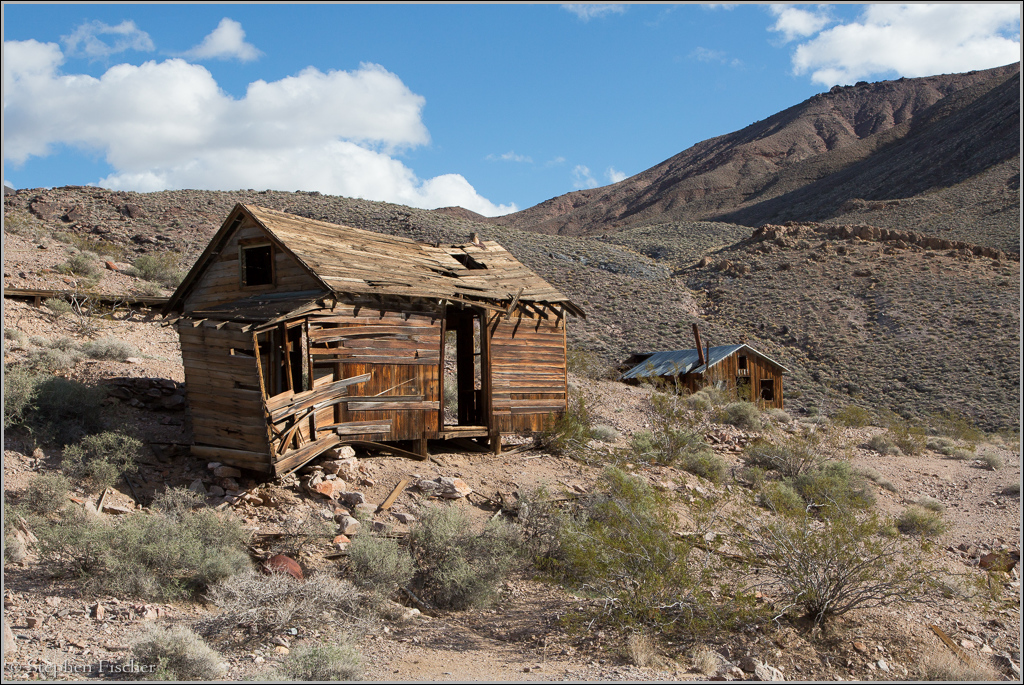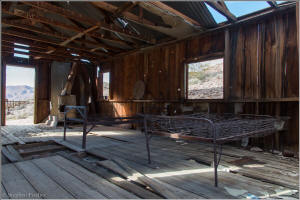Picture of the week
| Previous weeks |
 Feb
23, 2014 Feb
23, 2014 |
|
|
 Jan
26, 2014 Jan
26, 2014 |
 Jan
12, 2014 Jan
12, 2014 |
|
|
|
|
|
|
|
|
|
|
 Nov
17, 2013 Nov
17, 2013 |
|
|
|
|
 Oct
20, 2013 Oct
20, 2013 |
| Older |

Inyo Mine of Death Valley
 The
remote Inyo mining site in Death Valley. Myself and two friends traveled
here in a high clearance 4wd vehicle, camping overnight at this location.
If you are looking to get away from other people and the usual visited
locations in Death Valley, plus something off the beaten path, then this is
a good location. There are multiple intact buildings including this cabin
and an employee bunkhouse further in the distance, plus a ball mill nearby
for breaking down the ore. The Inyo mine was founded in 1905 after gold was
found here by a couple of prospectors. The big challenge was getting water
to the site, and ability haul ore out in an economical manner. Based on the
size of the strike here, it caught the attention of Charles Schwab, one of
the wealthiest men in the country at the time. According to Michel
DiGonnet's book Hiking Death Valley, this mining town grew to over 200
people by 1907, including its own post office, telephone, and even a daily
stage coach service. But before funding was complete to enable full mining
operations, the Great Financial Panic in the fall of 1907 resulted in funds
from investments running dry, and the mine went idle, finally being
abandoned in 1912. Around 1935 the mine reopened with some fairly
successful yields until closing again for good at the start of World War II
in 1941.
The
remote Inyo mining site in Death Valley. Myself and two friends traveled
here in a high clearance 4wd vehicle, camping overnight at this location.
If you are looking to get away from other people and the usual visited
locations in Death Valley, plus something off the beaten path, then this is
a good location. There are multiple intact buildings including this cabin
and an employee bunkhouse further in the distance, plus a ball mill nearby
for breaking down the ore. The Inyo mine was founded in 1905 after gold was
found here by a couple of prospectors. The big challenge was getting water
to the site, and ability haul ore out in an economical manner. Based on the
size of the strike here, it caught the attention of Charles Schwab, one of
the wealthiest men in the country at the time. According to Michel
DiGonnet's book Hiking Death Valley, this mining town grew to over 200
people by 1907, including its own post office, telephone, and even a daily
stage coach service. But before funding was complete to enable full mining
operations, the Great Financial Panic in the fall of 1907 resulted in funds
from investments running dry, and the mine went idle, finally being
abandoned in 1912. Around 1935 the mine reopened with some fairly
successful yields until closing again for good at the start of World War II
in 1941.
Due to the dry desert conditions, decay at sites like this tends to be extremely slow, with the largest contributor being vandalism from more reckless visitors. The rough road and lack of signage to get to this location tends limit the amount of traffic. Although temperatures during the day were in the 70's, later that evening snow flurry's moved in, and that night it dropped into the 20's, freezing the water bottle in my tent. One could imagine the harsh life the miners here had to endure while living here and trying to scratch out a living.
All content and images are property of Stephen Fischer Photography, copyright 2014. Last updated: 3/2/2014 ()